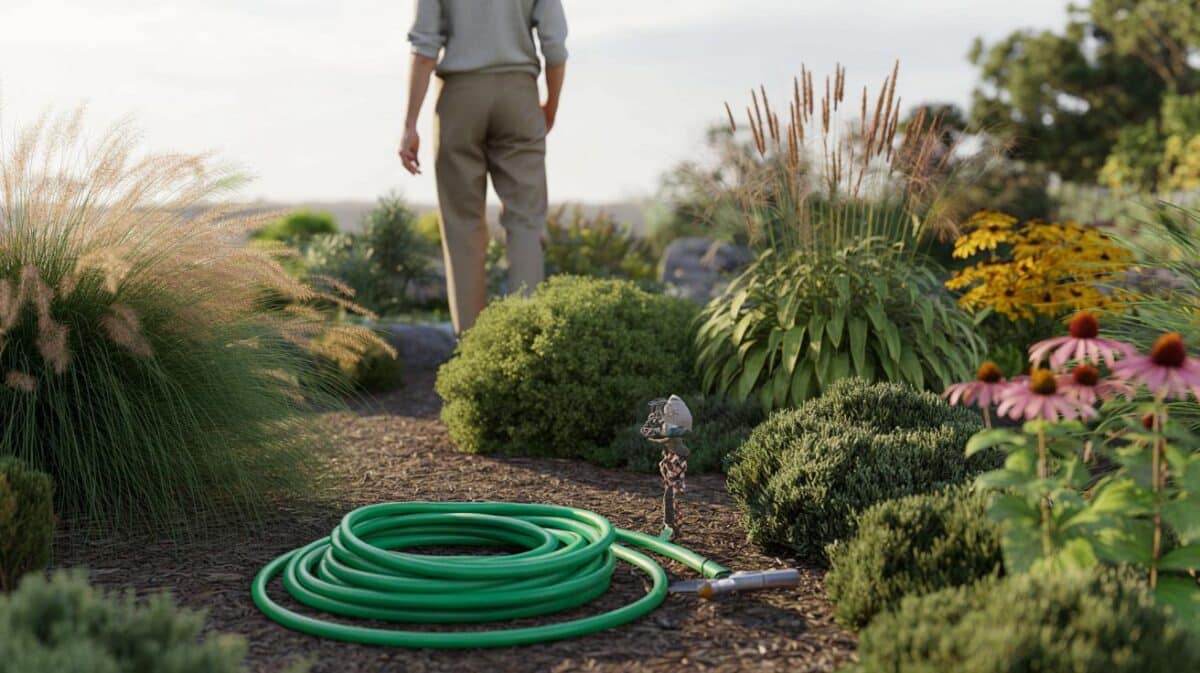Set your sights on a simple trio that shrugs off drought, locks in structure, and serves natural food through the bleak months. Plant in October, work the soil once, and watch a quiet corner fill with robins, tits and finches when gardens feel empty.
Why October changes everything
Soil still holds warmth in October, which drives root growth before the first hard frost. Rain arrives more regularly, so young plants settle with little help from a hose. Birds shift diet towards seeds and shelter, and a dry bed can supply both if you plan it now.
Plant in October to gain 6–8 weeks of rooting while soil stays warm; leave seedheads to feed birds for 4 months.
Work the top 20 centimetres of soil to improve drainage and rooting. Mix coarse sand or gravel into heavy ground to prevent waterlogging. Choose sun from the south or west to keep plants tough and floriferous.
The winning trio for dry corners
Rudbeckia: autumn suns that keep giving
Rudbeckia brings gold discs into late autumn and holds firm after frost. The dark seedheads stay packed with food that small birds reach easily. Upright stems also break the wind at ground level and create pockets of calm air.
Echinacea: sturdy cones for hungry finches
Echinacea carries pink, white or purple rays over stiff cones that ripen into rich seed. Goldfinches and greenfinches work those cones methodically. Dry stems stand all winter and shelter beneficial insects, which boosts spring pest control.
Nepeta: aromatic cushions that never quit
Nepeta forms low, felty mounds that edge paths and beds. Aromatic leaves handle frost and short freezes without fuss. Robins and tits dip into the foliage for cover during cold snaps. Late flowers still draw bees in a mild spell.
| Plant | Height | Spread | Spacing | Flowering | Water need | Bird value |
|---|---|---|---|---|---|---|
| Rudbeckia | 60–120 cm | 40–60 cm | 45–60 cm | July–October | Low once established | Seedheads feed tits and sparrows |
| Echinacea | 60–100 cm | 40–50 cm | 40–50 cm | July–November | Low once established | Cones feed finches for months |
| Nepeta | 25–50 cm | 60–90 cm | 35–45 cm | May–October | Very low | Dense cover and late nectar |
Planting plan you can copy this weekend
Set a simple layout that looks natural and works for birds. Use height and density to create food, cover and calm air.
- Pick a sunny spot with free-draining soil; avoid frost pockets and soggy edges.
- Loosen and amend 20 centimetres of soil; add 20–30% coarse grit on clay.
- Plant rudbeckia at the back for height and late colour.
- Group echinacea in the centre in clumps of 3–5 for a strong cone display.
- Edge the front with nepeta to knit the bed and shelter ground-feeders.
- Water in once, then mulch 5 cm with leafmould or composted bark to lock moisture.
- Space for air movement; avoid crowding to reduce mildew risk.
Do not deadhead after autumn. Let every cone and disc dry. Those seeds are winter rations, not garden waste.
As a guide, a 6 m² bed can take 6–8 rudbeckia, 8–10 echinacea and 10–14 nepeta. That density builds a living screen that birds use daily once frosts bite.
Who visits, and when
Different birds arrive as food shifts and temperatures fall. Activity builds from the first frost and peaks during cold spells.
- October–November: robins and dunnocks shelter low in nepeta and pick fallen seeds.
- November–January: blue tits and great tits work rudbeckia discs on calm, bright days.
- December–February: goldfinches and greenfinches cling to echinacea cones and feed in groups.
- Any cold snap: wrens flick through stems for spiders and hidden insects.
Place a shallow water saucer nearby on a brick. Refill often. Birds spend longer where food and water sit close to cover.
Low-care routine until spring
Water only in the first fortnight if the weather turns dry. After that, let roots chase moisture. Weed lightly once a month during the first season. Avoid fertiliser that forces soft growth and weakens drought tolerance.
Leave every stem standing until March. Cut back in one go when new shoots push. Rake mulch gently back into place after tidy-up. Thin or divide plants every three years to keep the bed airy and productive.
Real-world numbers that help you plan
- Time needed: 3–4 hours for a 6 m² bed, including soil prep and planting.
- Water saved: up to 800–1,200 litres over a dry summer per 10 m² compared with thirsty bedding.
- Cost ballpark: £60–£120 for 24–30 plants, depending on pot size and cultivars.
- Seed window: roughly 120 days of accessible seed from late November to late March.
Common pitfalls and easy fixes
Double-flowered cultivars can look lush but often hold fewer seeds and less nectar. Choose single blooms for food value. Powdery mildew can mark echinacea in shade or stale air; improve spacing and sun, not sprays. Slugs may nibble young nepeta in warm, wet spells; grit mulch and evening hand-picks keep damage down.
Cat traffic near ground-feeding birds raises risk. Add thorny shrubs at the rear, such as hawthorn or berberis, and keep any feeder or water tray a good 2 metres from ambush cover.
Smart additions for a richer winter scene
Thread in drought-proof companions over time. Stipa tenuissima, Pennisetum, Verbena bonariensis and native knapweed add movement, loft and extra seed. Small berried shrubs like cotoneaster extend food choice when seed runs low.
If your soil is very poor, add a thin 2–3 cm top-dressing of compost each autumn. That slow feed supports flowering without pushing sappy growth. A weekly 10‑minute check to top up water, lift fallen leaves off the saucer, and note which plant gets the most visits will sharpen the bed year by year.








